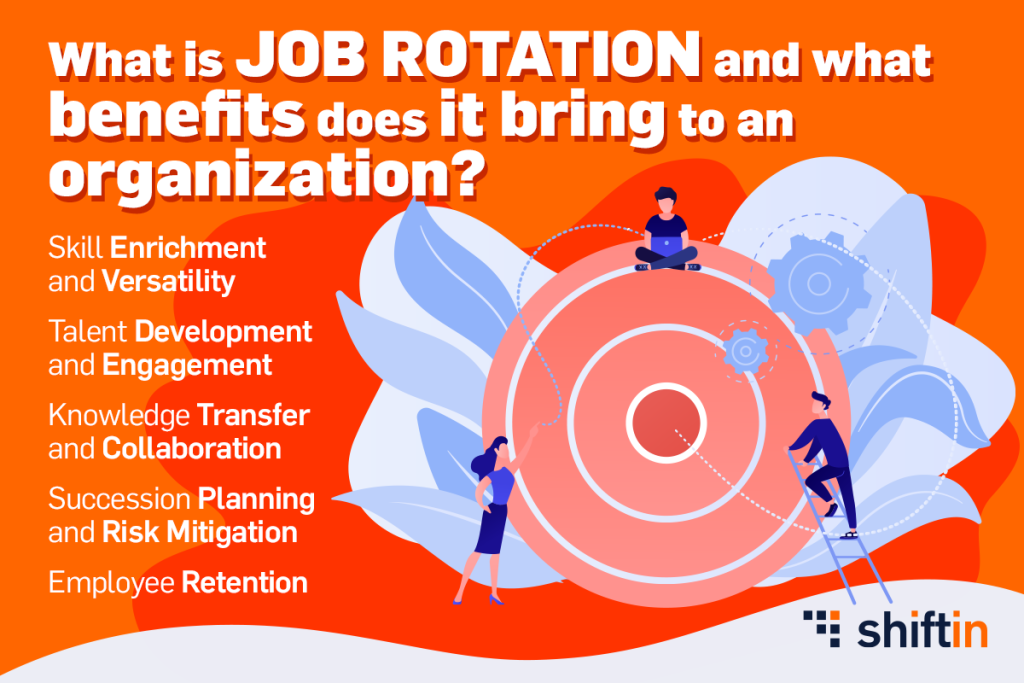- Îmbogățirea abilităților și versatilitatea prin job rotation
- Dezvoltarea și implicarea talentelor
- Transferul de cunoștințe și colaborarea
- Retenția și motivarea angajaților
- Cum ajuta un software de programare automata a turelor strategia de job rotation?
În domeniul managementului talentelor, rotația locurilor de muncă sau job rotation este o practică strategică care a atras atenția pentru avantajele sale multiple. Job rotation implică deplasarea sistematică a angajaților între diferite roluri, departamente sau funcții în cadrul unei organizații. Această schimbare deliberată permite indivizilor să se expună la sarcini, responsabilități și medii de lucru diverse.
Îmbogățirea abilităților și versatilitatea prin job rotation
În esența sa, job rotation servește ca un catalizator pentru îmbogățirea abilităților. Prin expunerea angajaților la diverse roluri, aceștia dobândesc un set mai larg de competențe și înțeleg mai bine diferitele fațete ale afacerii. Această diversitate a experiențelor le sporește versatilitatea, permițându-le să se adapteze mai ușor la cerințele schimbătoare ale locului de muncă și să contribuie eficient în roluri cu multiple fațete.
Dezvoltarea și implicarea talentelor
Job rotation joacă un rol esențial în dezvoltarea talentelor. Ea alimentează un grup de profesioniști versatili și bine pregătiți în cadrul organizației. Angajații, atunci când sunt expuși la diverse roluri, își descoperă punctele forte și interesele, deschizând calea pentru planuri de dezvoltare a carierei personalizate. Această expunere și această oportunitate de creștere stimulează semnificativ angajamentul și satisfacția angajaților, reducând riscul de stagnare sau de dezangajare.

Transferul de cunoștințe și colaborarea
Schimbul de cunoștințe și colaborarea între diferite echipe sau departamente este încurajat în strategiile de job rotation. Atunci când indivizii trec de la un rol la altul, ei aduc perspective și perspective noi, îmbogățind colaborarea interfuncțională. Acest schimb de cunoștințe și de bune practici cultivă o cultură a inovației, în care ideile circulă liber dincolo de silozurile organizaționale, ceea ce duce la îmbunătățirea proceselor și la rezolvarea problemelor.
Retenția și motivarea angajaților
Job rotation este un instrument puternic de retenție. Angajații se simt apreciați și investiți atunci când li se oferă oportunități de creștere profesională și de expunere la noi provocări. Varietatea și îmbogățirea pe care o aduce rotația locurilor de muncă poate reaprinde motivația, reducând ratele de rotație, deoarece angajații văd o cale clară de avansare în carieră în cadrul organizației.
Cum ajuta un software de programare automata a turelor strategia de job rotation?
Utilizarea unui software automatizat de programare a turelor, cum ar fi shiftin, poate simplifica foarte mult implementarea strategiilor de job rotation în cadrul unei organizații. Software-ul automatizat de programare a turelor ia în considerare diverși parametri, cum ar fi preferințele angajaților, seturile de competențe și cerințele de conformitate.
Cu interfața intuitivă și algoritmii inteligenți ai shiftin, organizațiile pot minimiza conflictele de programare, pot maximiza productivitatea forței de muncă și pot urmări cu ușurință mișcările angajaților între diferite roluri. Această integrare a tehnologiei nu numai că simplifică aspectele logistice ale rotației locurilor de muncă, dar asigură și o execuție mai organizată și mai eficientă, sporind succesul general al strategiei de rotație.
Strategia de job rotation transcende dincolo de o simplă practică de gestionare a talentelor; ea apare ca un imperativ strategic pentru dezvoltarea organizațională. Capacitatea sa de a favoriza îmbogățirea competențelor, dezvoltarea talentelor, transferul de cunoștințe, planificarea succesiunii și implicarea angajaților o face un atu neprețuit pentru întreprinderile moderne care caută o creștere durabilă.
Pe măsură ce organizațiile continuă să evolueze în peisajele dinamice ale pieței, valorificarea potențialului rotației locurilor de muncă nu numai că le echipează cu o forță de muncă versatilă, ci și alimentează o cultură a învățării continue, a adaptabilității și a inovării, propulsându-le spre un succes și o rezistență mai mari. shiftin reușește să ofere organizațiilor un avantaj competitiv pe o piață în schimbare rapidă, asigurându-se că forța de muncă este aliniată cu obiectivele de afaceri și pregătită pentru succes.


